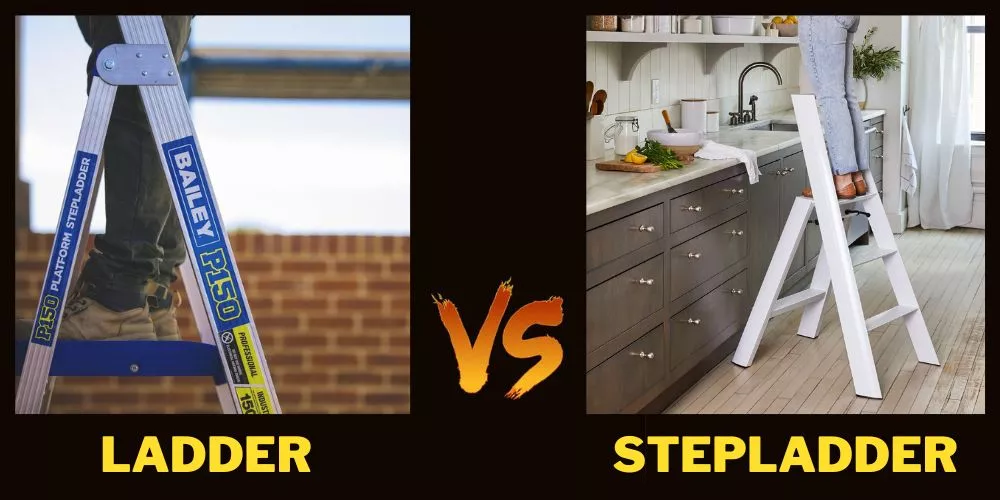Aluminum ladders, recognized for their minimal weight and durability, offer easy portability, making them a preferred choice for light tasks.
On the flip side, fiberglass ladders, while slightly heavier, are known for their non-conductive nature, hence are most commonly used around electricity and in professional construction.
Choosing between an aluminum ladder and a fiberglass ladder may seem like a trivial decision.
However, the choice between aluminum ladder vs fiberglass ladder could potentially impact the productivity, user safety, and even the outcome of the job in hand.

Therefore, through this article, we aim to provide you an in-depth comparison, addressing the significant aspects of these two ladder types, enabling you to make a conscious, more informed purchase decision.
Aluminum Ladder Vs Fiberglass Ladder: A Detailed Comparison
When selecting a ladder, the decision of whether to opt for an aluminum ladder or a fiberglass ladder often arises. This is particularly common among individuals planning DIY tasks, workers on construction sites, and electricians.
Here is a detailed comparison that analyzes aspects such as durability, stability, weight, cost, and safety of both ladder types.
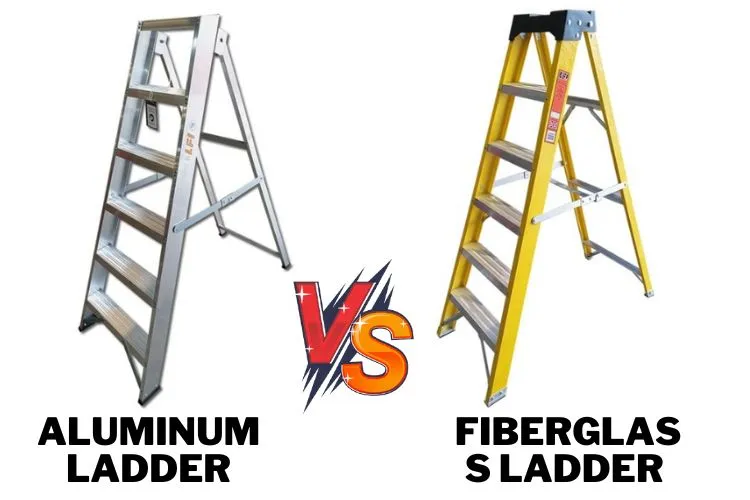
🪜 Durability
Both aluminum and fiberglass ladders boast considerable durability that enables them to withstand the routine wear and tear resulting from regular use.
- Aluminum ladders are resistant to elements such as corrosion and rust, owing to the intrinsic properties of aluminum. This characteristic makes them an excellent choice for outdoor tasks in diverse weather conditions, ranging from hot, humid climates to rainy ones.
- Fiberglass ladders, on the other hand, do not naturally resist the elements as much as their aluminum counterparts do. Continuous exposure to direct sunlight can cause the fiberglass material to degrade and weaken over time. However, for indoor applications or storage, they can last for several years without significant damage.
🪜 Stability
When it comes to strength and stability, both types of ladders are sturdy and reliable.
- Aluminum ladders harness the strength of aluminum, offering a solid foothold and balance. They are especially suitable for light tasks that don’t require maximum load-bearing capacity.
- Fiberglass ladders are generally sturdier and can bear heavy loads compared to aluminum ladders, making them the choice for heavy-duty tasks or professional construction jobs.
🪜 Weight
Ladder’s weight directly impacts handling and portability, and this is where aluminum ladders shine.
Aluminum ladders are known for their lightness, which allows for effortless transport and easy maneuvering, even when climbing to significant heights.
Contrarily, fiberglass ladders are denser and heavier due to the material composition, which can complicate handling and transportation, especially without any assistance.
🪜 Cost
Assessing the cost factor, aluminum ladders carry the day due to the comparative affordability of aluminum.
- Aluminum ladders are generally cheaper, providing a cost-effective solution for individuals looking for a budget-friendly option.
- Fiberglass ladders tend to lean on the expensive side. However, their higher price tag is often justified by their superior safety aspects, particularly in electricity-involved environments.
🪜 Safety
Safety is paramount in every working environment, and this is the most notable point of divergence between these two ladders.
While aluminum ladders are lightweight and durable, they do have a marked downside: they conduct electricity. This aspect presents a potential safety hazard when working around power lines or electrical equipment.
Fiberglass ladders, despite being denser, have an edge in safety since they are non-conductive. This inherent characteristic makes them a safer choice around electricity, earning them the favor of electricians and construction professionals.
In conclusion, the ideal choice between an aluminum ladder and a fiberglass ladder really depends on the exact requirements of the task at hand. If you’re looking for a light, affordable, and durable ladder for general usage, an aluminum ladder might be the perfect fit for you.
However, if you frequently work around electrical installations or need a ladder for heavy-duty tasks, a fiberglass ladder would be a sensible choice. Understanding the key characteristics of each ladder type empowers you to make a choice that ensures efficiency, safety, and value for money in your specific applications.
What are the disadvantages of aluminum ladders?
While aluminum ladders have many admirable attributes, they also come with a few drawbacks one should consider. Here’s a detailed look into their disadvantages:
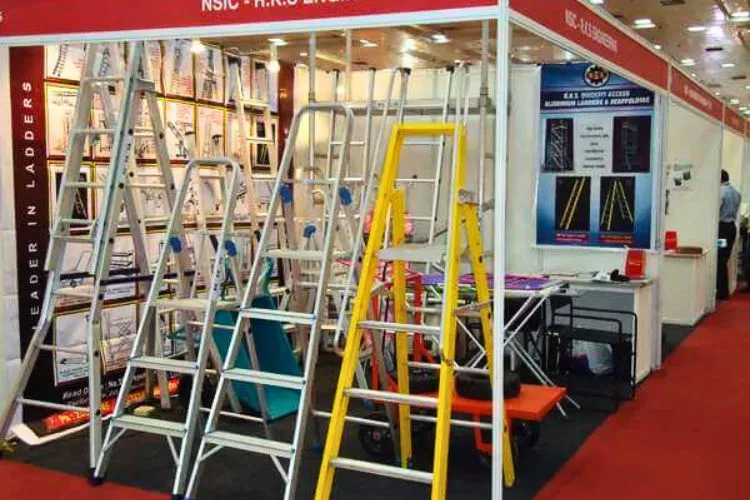
- Electricity Conduction: The topmost and critical disadvantage of aluminum ladders is their electricity conduction. Aluminum is a good conductor of electricity, making these ladders a potential risk around power lines or when working with electrical installations. People using aluminum ladders need to be cautious about where they place and how they use their ladder, especially in environments where electrical assets are present.
- Heat Conduction: In addition to conducting electricity, aluminum also conducts heat very efficiently. This characteristic can make an aluminum ladder uncomfortable or even hazardous to touch if left in the sun for extended periods. The risk of minor burns can occur from high temperatures absorbed from sun exposure.
- Potential for Twisting and Bending: Although aluminum is a durable material, it lacks the same level of rigidity as fiberglass or wood. Aluminum ladders, especially those not properly braced or those subjected to weights beyond their load-bearing capacity, can twist or bend over time. This affects their stability and can pose a safety risk.
- Dents and Bends: Aluminum, being softer than fiberglass, can become dented or bent when impacted. These deformations may weaken the structural integrity of the ladder and compromise its safety.
- Limited Weight Capacity: Aluminum ladders are typically designed to handle lower weight capacities compared to fiberglass ladders. Heavy-duty tasks that exceed the weight limit of the ladder can lead to damaging and potentially dangerous situations.
- Noise: Aluminum ladders tend to make more noise when being moved or handled compared to other types of ladders. This might be something to consider in environments where noise could be problematic.
In conclusion, while aluminum ladders are lightweight and resistant to corrosion, their drawbacks center around electricity and heat conduction, potential for bending or twisting, susceptibility to dents, limited weight capacity, and noise generation.
It’s critical to consider these factors to ensure the ladder you choose aligns with your needs and the work environment.
What are the disadvantages of fiberglass ladders?
Fiberglass ladders, while noted for their safety and durability, do come with a set of downsides that can impact their functionality and convenience:
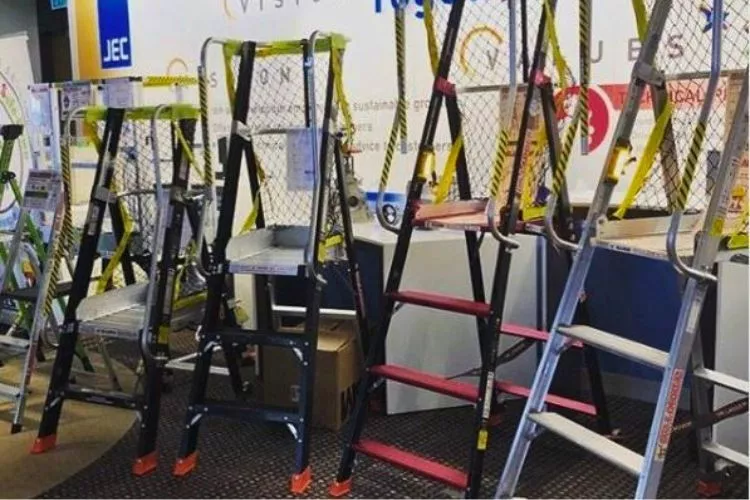
- Weight: The top disadvantage of fiberglass ladders is their weight. Fiberglass ladders tend to be heavier than their aluminum counterparts because the materials used in their production are heavy and dense. This makes them more difficult to lift, move around, and transport, which could be disadvantageous in dynamic work environments or for individuals working alone.
- Cost: Generally, fiberglass ladders are more expensive compared to aluminum or wood ladders. The high cost can be a deterrent for many potential buyers, especially those on a tight budget or those who don’t require the ladder’s added strength and non-conductive property.
- Weather Impact: Although fiberglass ladders are durable, they can deteriorate in certain conditions. Extended exposure to sunlight can cause the material to weaken and fray over time. This degradation can impact the ladder’s structural integrity.
- Difficulty to Repair: In contrast to aluminum ladders, significant damage to a fiberglass ladder can be tough to repair. If the fiberglass in the ladder were to crack, you’d likely need a professional repair or have to replace the entire ladder.
While the drawbacks are crucial to consider, the choice of a ladder largely depends on the specific needs and preferences of the user. For someone who values safety around electricity and doesn’t mind the added weight, a fiberglass ladder could be a fitting choice.
On the other hand, if weight and cost are primary concerns, an aluminum ladder might be more suitable.
What is the best material for a ladder?
The “best” material for a ladder depends significantly on the specific usage and the environment in which it will be used.
However, from the search results, three materials seem to be the most popular: Wood, Aluminum, and Fiberglass.
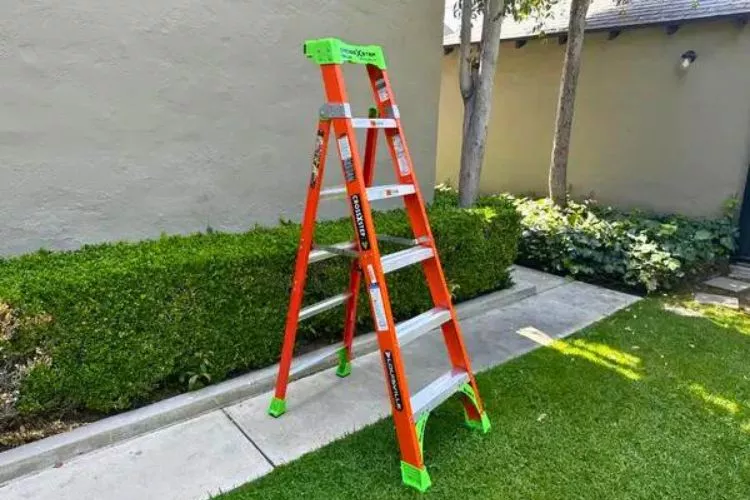
- Wood Ladders are popular due to their aesthetic appeal and their insulating properties, which make them safe for electrical work. However, they’re heavy and not resistant to weather, which can lead to warping or rotting over time.
- Aluminum Ladders are admired for their lightweight and resistance to rust, making them suitable for both indoor and outdoor use. However, they are not safe for electrical work due to their conductivity.
- Fiberglass Ladders are the favored choice for many professional settings. Although they are heavier than their aluminum counterparts, they are highly durable and safe for electrical work due to their non-conductive nature. Additionally, they’re hard wearing and not prone to bending or twisting.
Ultimately, the best material for a ladder depends on the given context. If portability and cost-effectiveness is your top priority, an Aluminum ladder may be the best choice. For electrical work or heavy-duty usage, Fiberglass would be ideal due to its safety features and robustness.
For home use
When selecting a ladder for home use, it’s important to consider the advantages and disadvantages of different materials.
Aluminum Ladders are a popular choice due to their lightweight nature, which makes them easy to carry and maneuver around the home. They also tend to be less expensive than fiberglass ladders, which can be an important factor for many homeowners.
However, these ladders conduct electricity, so caution must be exercised when using aluminum ladders around electricity. They can also heat up if left in the sun, which could pose issues if the ladder is stored outdoors or used for outdoor work.
On the other hand, Fiberglass Ladders are highly durable and safe for use around electricity because they don’t conduct electricity. While they are a bit heavier and more expensive than aluminum ladders, the longevity, durability, and improved safety of fiberglass can offset the higher cost.
In summary, both aluminum and fiberglass ladders have their merits for home use. Your choice would best be based on considering the specific needs of your tasks, budget, and safety requirements.
When Should You Avoid Using an Aluminum Ladder?
While aluminum ladders are beneficial for their lightweight and corrosion-resistant properties, some situations warrant avoiding their use:
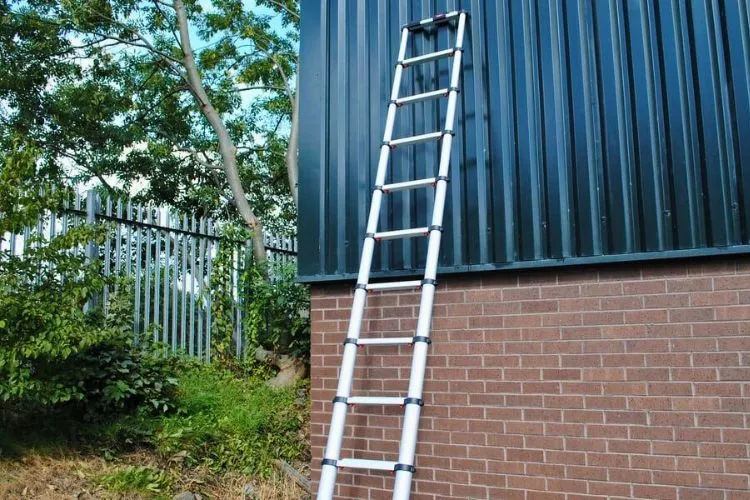
- Working Around Electricity: Aluminum ladders conduct electricity very well. This conductivity makes them hazardous when working around power lines or when dealing with any electrical work. In such an environment, the use of a non-conductive ladder such as a fiberglass model is safest.
- High-Temperature Environments: Aluminum ladders can become extremely hot when left exposed to sun or heat for extended periods. If you expect to work in a hot environment or in direct sunlight, an aluminum ladder may not be your best choice.
- Heavy-Duty Tasks: Aluminum tends to warp under heavier loads, which affects its stability and safety. If you will be using your ladder for heavy-duty work or if the person using the ladder is heavier, you might want to avoid aluminum ladders.
When Should You Avoid Using a Fiberglass Ladder?
Fiberglass ladders are well-known for their durability and safety due to their non-conductive nature. However, certain circumstances might call for alternative ladder types:
- When Portability is a Priority: Fiberglass ladders are heavier than their aluminum counterparts. This weight can make it challenging to move them from place to place, particularly for individuals who work alone or need to transport their ladder frequently.
- Limited Budget: Fiberglass ladders are typically more expensive than aluminum ladders. If you’re on a budget, you might want to stick to aluminum or wood ladders, which offer good functionality at a lower cost. However, remember that the ladder’s safety and suitability for the tasks at hand should always be a high priority.
- Prolonged Sun Exposure: Despite their d
- urability, fiberglass ladders can deteriorate under extended exposure to ultraviolet (UV) light. The material can become brittle and lose its strength over time, compromising the ladder’s safety. If the ladder is expected to be left outside in the sun for prolonged periods, the use of a fiberglass ladder might not be ideal.
Remember, your choice should ultimately align with your work requirements and safety needs.
Conclusion:
Both aluminum and fiberglass ladders have their unique strengths and drawbacks, ultimately affecting their appropriateness based on specific usage and requirements.
While aluminum ladders might appeal to those seeking cost-effectiveness and portability, their unsuitability for electrical or high-temperature tasks limits their use in particular situations.
Conversely, Fiberglass ladders, known for their durability and non-conductivity, become ideal for heavy-duty and electrical tasks, notwithstanding their higher cost and weight.
Therefore, no one ladder material ‘outweighs’ the other universally; the choice lies in the hands of the user, aligning with their specific needs, safety considerations, and budget constraints.


